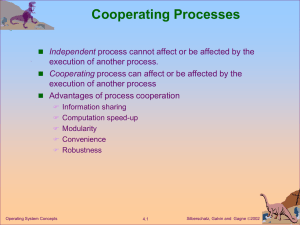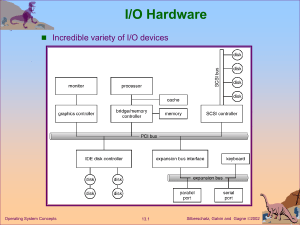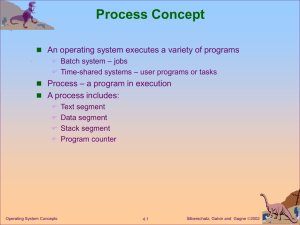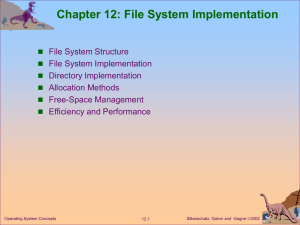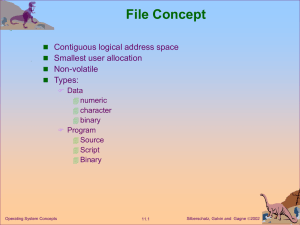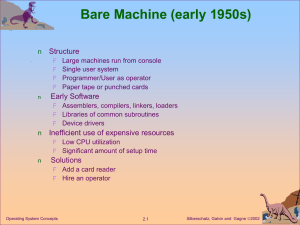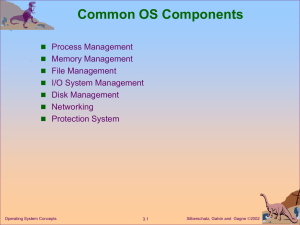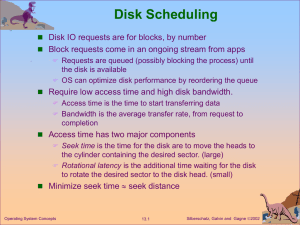Silberschatz synchronization.
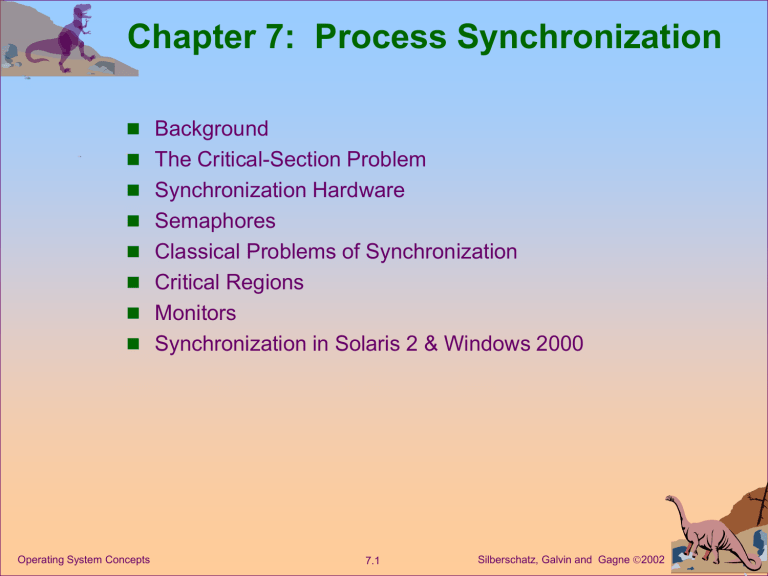
Chapter 7: Process Synchronization
Background
The Critical-Section Problem
Synchronization Hardware
Semaphores
Classical Problems of Synchronization
Critical Regions
Monitors
Synchronization in Solaris 2 & Windows 2000
7.1
Silberschatz, Galvin and Gagne
2002 Operating System Concepts
Background
Concurrent access to shared data may result in data inconsistency.
Maintaining data consistency requires mechanisms to ensure the orderly execution of cooperating processes.
Shared-memory solution to bounded-butter problem
(Chapter 4) allows at most n – 1 items in buffer at the same time. A solution, where all N buffers are used is not simple.
Suppose that we modify the producer-consumer code by adding a variable counter , initialized to 0 and incremented each time a new item is added to the buffer
7.2
Silberschatz, Galvin and Gagne
2002 Operating System Concepts
Bounded-Buffer
Shared data
#define BUFFER_SIZE 10 typedef struct {
. . .
} item ; item buffer[BUFFER_SIZE]; int in = 0; int out = 0; int counter = 0;
7.3
Silberschatz, Galvin and Gagne
2002 Operating System Concepts
Bounded-Buffer
Producer process item nextProduced; while (1) { while (counter == BUFFER_SIZE)
; /* do nothing */ buffer[in] = nextProduced; in = (in + 1) % BUFFER_SIZE; counter++;
}
7.4
Silberschatz, Galvin and Gagne
2002 Operating System Concepts
Bounded-Buffer
Consumer process item nextConsumed; while (1) { while (counter == 0)
; /* do nothing */ nextConsumed = buffer[out]; out = (out + 1) % BUFFER_SIZE; counter--;
}
7.5
Silberschatz, Galvin and Gagne
2002 Operating System Concepts
Bounded Buffer
The statements counter++; counter--; must be performed atomically .
Atomic operation means an operation that completes in its entirety without interruption.
7.6
Silberschatz, Galvin and Gagne
2002 Operating System Concepts
Bounded Buffer
The statement “ count++ ” may be implemented in machine language as: register1 = counter register1 = register1 + 1 counter = register1
The statement “ count — ” may be implemented as: register2 = counter register2 = register2 – 1 counter = register2
7.7
Silberschatz, Galvin and Gagne
2002 Operating System Concepts
Bounded Buffer
If both the producer and consumer attempt to update the buffer concurrently, the assembly language statements may get interleaved.
Interleaving depends upon how the producer and consumer processes are scheduled.
Operating System Concepts 7.8
Silberschatz, Galvin and Gagne
2002
Bounded Buffer
Assume counter is initially 5. One interleaving of statements is: producer: register1 = counter ( register1 = 5 ) producer: register1 = register1 + 1 ( register1 = 6 ) consumer: register2 = counter ( register2 = 5 ) consumer: register2 = register2 – 1 ( register2 = 4 ) producer: counter = register1 ( counter = 6 ) consumer: counter = register2 ( counter = 4 )
The value of count may be either 4 or 6, where the correct result should be 5.
7.9
Silberschatz, Galvin and Gagne
2002 Operating System Concepts
Race Condition
Race condition : The situation where several processes access – and manipulate shared data concurrently. The final value of the shared data depends upon which process finishes last.
To prevent race conditions, concurrent processes must be synchronized .
Operating System Concepts 7.10
Silberschatz, Galvin and Gagne
2002
The Critical-Section Problem
n processes all competing to use some shared data
Each process has a code segment, called critical section , in which the shared data is accessed.
Problem – ensure that when one process is executing in its critical section, no other process is allowed to execute in its critical section.
Operating System Concepts 7.11
Silberschatz, Galvin and Gagne
2002
Solution to Critical-Section Problem
1.
Mutual Exclusion . If process P i is executing in its critical section, then no other processes can be executing in their critical sections.
2.
Progress . If no process is executing in its critical section and there exist some processes that wish to enter their critical section, then the selection of the processes that will enter the critical section next cannot be postponed indefinitely.
3.
Bounded Waiting . A bound must exist on the number of times that other processes are allowed to enter their critical sections after a process has made a request to enter its critical section and before that request is granted.
Assume that each process executes at a nonzero speed
No assumption concerning relative speed of the n processes.
Silberschatz, Galvin and Gagne
2002 Operating System Concepts 7.12
Initial Attempts to Solve Problem
Only 2 processes, P
0 and P
1
General structure of process P i
(other process P j
) do { entry section critical section exit section reminder section
} while (1) ;
Processes may share some common variables to synchronize their actions.
7.13
Silberschatz, Galvin and Gagne
2002 Operating System Concepts
Algorithm 1
Shared variables:
int turn ; initially turn = 0 turn - i
P i can enter its critical section
Process P i do { while (turn != i) ; critical section turn = j ; reminder section
} while (1) ;
Satisfies mutual exclusion, but not progress: With only one process, after one loop no one enters the critical section
Operating System Concepts 7.14
Silberschatz, Galvin and Gagne
2002
Algorithm 2
Shared variables
boolean flag[2] ; initially flag [0] = flag [1] = false.
flag [i] = true
P i ready to enter its critical section
Process P i do { flag[i] := true; while (flag[j]) ; critical section flag [i] = false; remainder section
} while (1);
Satisfies mutual exclusion, but not progress requirement:
Both flags might be true and no one will enter the critical section.
Operating System Concepts 7.15
Silberschatz, Galvin and Gagne
2002
Algorithm 3
Combined shared variables of algorithms 1 and 2.
Process P i do { flag [i]:= true; turn = j; while (flag [j] and turn = j) ; critical section flag [i] = false; remainder section
} while (1);
Meets all three requirements; solves the critical-section problem for two processes.
7.16
Silberschatz, Galvin and Gagne
2002 Operating System Concepts
Synchronization Hardware
.
Test and modify the content of a word atomically boolean TestAndSet(boolean &target) { boolean rv = target; tqrget = true;
} return rv;
7.17
Silberschatz, Galvin and Gagne
2002 Operating System Concepts
Mutual Exclusion with Test-and-Set
Shared data: boolean lock = false;
Process P i do { while (TestAndSet(lock)) ; critical section lock = false; remainder section
}
7.18
Silberschatz, Galvin and Gagne
2002 Operating System Concepts
Synchronization Hardware
Atomically swap two variables.
void Swap(boolean &a, boolean &b) { boolean temp = a; a = b; b = temp;
}
Operating System Concepts 7.19
Silberschatz, Galvin and Gagne
2002
Mutual Exclusion with Swap
Shared data (initialized to false ): boolean lock;
Process P i do { key = true; while (key == true)
Swap(lock,key); critical section lock = false; remainder section
}
7.20
Silberschatz, Galvin and Gagne
2002 Operating System Concepts
Semaphores
Synchronization tool that does not require busy waiting.
Semaphore S – integer variable can only be accessed via two indivisible (atomic) operations wait ( S ): while S
0 do no-op ;
S --; signal ( S ):
S++;
7.21
Silberschatz, Galvin and Gagne
2002 Operating System Concepts
Critical Section of
n
Processes
Shared data: semaphore mutex; // initially mutex = 1
Process Pi: do { wait(mutex); critical section signal(mutex); remainder section
} while (1);
7.22
Silberschatz, Galvin and Gagne
2002 Operating System Concepts
Semaphore Implementation
Define a semaphore as a record typedef struct { int value; struct process *L;
} semaphore;
Assume two simple operations:
block suspends the process that invokes it.
wakeup( P ) resumes the execution of a blocked process P .
7.23
Silberschatz, Galvin and Gagne
2002 Operating System Concepts
Implementation
Semaphore operations now defined as wait ( S ):
S.value--; if (S.value < 0) { add this process to S.L; block;
} signal ( S ):
S.value++; if (S.value <= 0) { remove a process P from S.L; wakeup(P);
}
7.24
Silberschatz, Galvin and Gagne
2002 Operating System Concepts
Semaphore as a General Synchronization Tool
Execute B in P j only after A executed in P i
Use semaphore flag initialized to 0
Code:
P i
P j
A signal ( flag ) wait (
B flag )
Operating System Concepts 7.25
Silberschatz, Galvin and Gagne
2002
Deadlock and Starvation
Deadlock – two or more processes are waiting indefinitely for an event that can be caused by only one of the waiting processes.
Let S and Q be two semaphores initialized to 1
P
0 wait ( S ); wait ( Q );
P wait wait
(
(
1
Q
S
);
); signal ( S ); signal ( Q ); signal ( Q ) signal ( S );
Starvation – indefinite blocking. A process may never be removed from the semaphore queue in which it is suspended.
7.26
Silberschatz, Galvin and Gagne
2002 Operating System Concepts
Two Types of Semaphores
Counting semaphore – integer value can range over an unrestricted domain.
Binary semaphore – integer value can range only between 0 and 1; can be simpler to implement.
Can implement a counting semaphore S as a binary semaphore.
Operating System Concepts 7.27
Silberschatz, Galvin and Gagne
2002
Implementing
S
as a Binary Semaphore
Data structures:
Initialization: binary-semaphore S1, S2; int C:
S1 = 1
S2 = 0
C = initial value of semaphore S
Operating System Concepts 7.28
Silberschatz, Galvin and Gagne
2002
Implementing
S
wait operation wait(S1);
C--; if (C < 0) {
} signal(S1); signal(S1); wait(S2);
signal operation wait(S1);
C ++; if (C <= 0) signal(S2); else signal(S1);
7.29
Silberschatz, Galvin and Gagne
2002 Operating System Concepts
Bounded-Buffer Problem
Shared data semaphore full, empty, mutex;
Initially: full = 0, empty = n, mutex = 1
Operating System Concepts 7.30
Silberschatz, Galvin and Gagne
2002
Bounded-Buffer Problem Producer Process
do {
… produce an item in nextp
… wait(empty); wait(mutex);
… add nextp to buffer
… signal(mutex); signal(full);
} while (1);
7.31
Silberschatz, Galvin and Gagne
2002 Operating System Concepts
Bounded-Buffer Problem Consumer Process
do { wait(full) wait(mutex);
… remove an item from buffer to nextc
… signal(mutex); signal(empty);
… consume the item in nextc
…
} while (1);
7.32
Silberschatz, Galvin and Gagne
2002 Operating System Concepts
